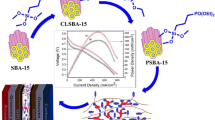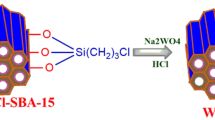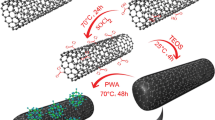Abstract
Hydrogen is believed to be the clean energy source for the future, since water is the only by-product of hydrogen fuel cell. However, the great obstacle for the blooming of hydrogen economy is the development of safe, efficient, and economical onboard hydrogen storage medium. This paper describes the hydrogen storage performance of microporous polyetherimide/acid-treated halloysite nanotube/activated hexagonal boron nitride (PEI/A-HNT/Ah-BN) hybrid nanocomposite membranes. The microporous PEI/A-HNT/Ah-BN hybrid nanocomposite membranes were synthesized by a facile phase inversion technique. The synthesized hybrid nanocomposite membranes were characterized extensively by techniques like X-ray diffraction (XRD), micro-Raman spectroscopy, Fourier transform infrared spectroscopy (FTIR), energy dispersive X-ray spectroscopy (EDX), scanning electron microscopy (SEM), thermogravimetric analysis (TGA), and CHNS elemental analysis. The microporous throughout the membrane matrix and the superior dispersion of A-HNT, Ah-BN nanomaterials on the surface of PEI were confirmed by SEM. The hydrogen storage properties were investigated by Sieverts-like hydrogenation setup. The outcomes indicated that the PEI/A-HNT/Ah-BN hybrid nanocomposite membrane exhibits best hydrogen storage capacity as 4.2 wt% compared with PEI/A-HNT (3.6 wt%), PEI/Ah-BN (2.4 wt%), and pristine PEI (0.8 wt%) membranes. Furthermore, the binding energy of stored hydrogen for PEI/A-HNT/Ah-BN hybrid nanocomposite is found to be 0.32 eV. In addition, the reusability of PEI/A-HNT/Ah-BN hybrid nanocomposite was studied and also exhibited good long-term stability (91.43%) even after 5th cycles. These results indicate that the proposed microporous PEI/A-HNT/Ah-BN hybrid nanocomposite membrane strategy provides a direction for new materials that meet the U.S. Department of Energy (DOE) hydrogen storage targets 2020 for fuel call applications.














Similar content being viewed by others
References
Yilmaz F, Balta MT, Selbaş R (2016) A review of solar based hydrogen production methods. Renew Sust Energ Rev 56:171–178
Wei TY, Lim KL, Tseng YS, Chan SLI (2017) A review on the characterization of hydrogen in hydrogen storage materials. Renew Sust Energ Rev 79:1122–1133
Rusman NAA, Dahari M (2016) A review on the current progress of metal hydrides material for solid-state hydrogen storage applications. Int J Hydrog Energy 41:12108–12126
Sherif S, Barbir F, Veziroglu T (2005) Towards a hydrogen economy. Electr J 18:62–76
Cipriani G, Dio VD, Genduso F, Cascia DL, Liga R, Miceli R, Galluzzo GR (2014) Perspective on hydrogen energy carrier and its automotive applications. Int J Hydrog Energy 39:8482–8494
Xie G, Zhang K, Guo BD, Liu Q, Fang L, Gong JR (2013) Graphene-based materials for hydrogen generation from light-driven water splitting. Adv Mater 25:3820–3839
Dutta S (2014) A review on production, storage of hydrogen and its utilization as an energy resource. Ind Eng Chem Res 20:1148–1156
Balat M (2008) Potential importance of hydrogen as a future solution to environmental and transportation problems. Int J Hydrog Energy 33:4013–4029
Hwang HT, Varma A (2014) Hydrogen storage for fuel cell vehicles. Curr Opin Chem Eng 5:42–48
Durbin DJ, Malardier-Jugroot C (2013) Review of hydrogen storage techniques for on board vehicle applications. Int J Hydrog Energy 38:14595–14617
Niaz S, Manzoor T, Pandith AH (2015) Hydrogen storage: materials, methods and perspectives. Renew Sust Energ Rev 50:457–469
McKeown NB, Gahnem B, Msayib KJ, Budd PM, Tattershall CE, Mahmood K, Tan S, Book D, Langmi HW, Walton A (2006) Towards polymer-based hydrogen storage materials: engineering ultramicroporous cavities within polymers of intrinsic microporosity. Angew Chem Int Ed 45:1804–1807
Wood CD, Tan B, Trewin A, Niu H, Bradshaw D, Rosseinsky MJ, Khimyak YZ, Campbell NL, Kirk R, Stockel E, Cooper AI (2007) Hydrogen storage in microporous hypercrosslinked organic polymer networks. Chem Mater 19:2034–2048
Ramimoghadam D, Gray EM, Webb CJ (2016) Review of polymers of intrinsic microporosity for hydrogen storage applications. Int J Hydrog Energy 41:16944–16965
Budd PM, Butler A, Selbie J, Mahmood K, McKeown NB, Ghanem B, Msayib K, Book D, Waltonc A (2007) The potential of organic polymer-based hydrogen storage materials. Phys Chem Chem Phys 9:1802–1808
McKeown NB, Budd PM, Book D (2007) Microporous polymers as potential hydrogen storage materials. Rapid Commun 28:995–1002
Jurczyka MU, Kumar A, Srinivasan S, Stefanakos E (2007) Polyaniline-based nanocomposite materials for hydrogen storage. Int J Hydrog Energy 32:1010–1015
Zhang C, Zhu P-C, Tan L, Luo L-N, Liu Y, Liu J-M, Ding S-Y, Tan B, Yang X-L, Xu H-B (2016) Synthesis and properties of organic microporous polymers from the monomer of hexaphenylbenzene based triptycene. Polymer 82:100–104
Weber J, Antonietti M, Thomas A (2008) Microporous networks of high-performance polymers: elastic deformations and gas sorption properties. Macromolecules 41:2880–2885
Pedicini R, Sacca A, Carbone A, Passalacqua E (2011) Hydrogen storage based on polymeric material. Int J Hydrog Energy 36:9062–9068
Lee J-Y, Wood CD, Bradshaw D, Rosseinsky MJ, Cooper AI (2006) Hydrogen adsorption in microporous hypercrosslinked polymers. Chem Commun 25:2670–2672
Germain J, Hradil J, Frechet JMJ, Svec F (2006) High surface area nanoporous polymers for reversible hydrogen storage. Chem Mater 18:4430–4435
Silambarasan D, Vasu V, Iyakutti K (2014) Water soluble polymer-SWCNT-based composite for hydrogen storage. IEEE Trans Nanotechnol 13:261–267
Kim BH, Hong WG, Lee SM, Yun YJ, Yu HY, Oh S-Y, Kim CH, Kim YY, Kim HJ (2010) Enhancement of hydrogen storage capacity in polyaniline-vanadium pentoxide nanocomposites. Int J Hydrog Energy 35:1300–1304
Muthu RN, Rajashabala S, Kannan R (2015) Synthesis and characterization of polymer (sulfonated poly-ether-ether -ketone) based nanocomposite (h-boron nitride) membrane for hydrogen storage. Int J Hydrog Energy 40:1836–1845
Chen Y, Zhu H, Liu Y (2011) Preparation of activated rectangular polyaniline-based carbon tubes and their application in hydrogen adsorption. Int J Hydrog Energy 36:11738–11745
Li A, Lu R-F, Wang Y, Wang X, Han K-L, Deng W-Q (2010) Lithium-doped conjugated microporous polymers for reversible hydrogen storage. Angew Chem Int Ed 49:3330–3333
Makridis SS, Gkanas EI, Panagakos G, Kikkinides ES, Stubos AK, Wagener P, Barcikowski S (2013) Polymer-stable magnesium nanocomposites prepared by laser ablation for efficient hydrogen storage. Int J Hydrog Energy 38:11530–11535
Cho SJ, Choo K, Kim DP, Kim JW (2007) H2 sorption in HCl-treated polyaniline and polypyrrole. Catal Today 120:336–340
Lvov Y, Wang W, Zhang L, Fakhrullin R (2016) Halloysite clay nanotubes for loading and sustained release of functional compounds. Adv Mater 28:1227–1250
Zhang Y, Tang A, Yang H, Ouyang J (2016) Applications and interfaces of halloysite nanocomposites. Appl Clay Sci 119:8–17
Yuan P, Tan D, Annabi-Bergaya F (2015) Properties and applications of halloysite nanotubes: recent research advances and future prospects. Appl Clay Sci 112–113:75–93
Massaro M, Amorati R, Cavallaro G, Guernelli S, Lazzara G, Milioto S, Noto R, Poma P, Riela S (2016) Direct chemical grafted curcumin on halloysite nanotubes as dual-responsive prodrug for pharmacological applications. Colloids Surf B 140:505–513
Jin J, Ouyang J, Yang H (2017) Pd nanoparticles and MOFs synergistically hybridized Halloysite nanotubes for hydrogen storage. Nanoscale Res Lett 12:240
Attia NF, Menemparabath MM, Arepalli S, Geckeler KE (2013) Inorganic nanotube composites based on polyaniline: potential room-temperature hydrogen storage materials. Int J Hydrog Energy 38:9251–9262
Jin J, Zhang Y, Ouyang J, Yang H (2014) Halloysite nanotubes as hydrogen storage materials. Phys Chem Miner 41:323–331
Muthu RN, Rajashabala S, Kannan R (2016) Facile synthesis and characterization of a reduced graphene oxide/halloysite nanotubes/hexagonal boron nitride (RGO/HNT/h-BN) hybrid nanocomposite and its potential application in hydrogen storage. RSC Adv 6:79072–79084
Muthu RN, Rajashabala S, Kannan R (2016) Synthesis, characterization of hexagonal boron nitride nanoparticles decorated halloysite nanoclay composite and its application as hydrogen storage medium. Renew Energy 90:554–564
Muthu RN, Rajashabala S, Kannan R (2018) Synthesis of polyetherimide/halloysite nanotubes (PEI/HNTs) based nanocomposite membrane towards hydrogen storage. AIP Conf Proc 1942:050107
Weng Q, Wang X, Wang X, Bandoa Y, Golberg D (2016) Functionalized hexagonal boron nitride nanomaterials: emerging properties and applications. Chem Soc Rev 45:3989–4012
Wang J, Ma F, Sun M (2017) Graphene, hexagonal boron nitride, and their heterostructures: properties and applications. RSC Adv 7:16801–16822
Golberg D, Bando Y, Huang Y, Terao T, Mitome M, Tang C, Zhi C (2010) Boron nitride nanotubes and nanosheets. ACS Nano 4:2979–2993
Duan X, Yang Z, Chen L, Tian Z, Cai D, Wang Y, Jia D, Zhou Y (2016) Review on the properties of hexagonal boron nitride matrix composite ceramics. J Eur Ceram Soc 36:3725–3737
Weng Q, Wang X, Zhi C, Bando Y, Golberg D (2013) Boron nitride porous microbelts for hydrogen storage. ACS Nano 7:1558–1565
Weng Q, Wang X, Bando Y, Golberg D (2014) One-step template-free synthesis of highly porous boron nitride microsponges for hydrogen storage. Adv Energy Mater 4:1301525
Muthu RN, Rajashabala S, Kannan R (2017) Hydrogen storage performance of lithium borohydride decorated activated hexagonal boron nitride nanocomposite for fuel cell applications. Int J Hydrog Energy 42:15586–15596
Ma R, Bando Y, Zhu H, Sato T, Xu C, Wu D (2002) Hydrogen uptake in boron nitride nanotubes at room temperature. J Am Chem Soc 124:7672–7673
Reddy ALM, Tanur AE, Walker GC (2010) Synthesis and hydrogen storage properties of different types of boron nitride nanostructures. Int J Hydrog Energy 35:4138–4143
Tang C, Bando Y, Ding X, Qi S, Golberg D (2002) Catalyzed collapse and enhanced hydrogen storage of BN nanotubes. J Am Chem Soc 124:14550–14551
Li J, Lin J, Xu X, Zhang X, Xue Y, Mi J, Mo Z, Fan Y, Hu L, Yang X, Zhang J, Meng F, Yuan S, Tang C (2013) Porous boron nitride with a high surface area: hydrogen storage and water treatment. Nanotechnology 24:155603 (7pp)
Lei W, Zhang H, Wu Y, Zhang B, Liu D, Qin S, Liu Z, Liu L, Ma Y, Chen Y (2014) Oxygen-doped boron nitride nanosheets with excellent performance in hydrogen storage. Nano Energy 6:219–224
Dundar-Tekkaya E, Yurum Y (2016) Mesoporous MCM-41 material for hydrogen storage: a short review. Int J Hydrog Energy 41:9789–9795
Ghasemi M, Daud WRW, Alam J, Ilbeygi H, Sedighi M, Ismail AF, Yazdi MH, Aljlil SA (2016) Treatment of two different water resources in desalination and microbial fuel cell processes by poly sulfone/sulfonated poly ether ether ketone hybrid membrane. Energy 96:303–313
Strathmann H (1991) Fundamentals of membrane separation processes. In: Costa CA, Cabral JS (eds) Chromatographic and membrane processes in biotechnology, NATO ASI Series (Series E: Applied Sciences), vol 204. Springer, Dordrecht
Xi J, Qiu X, Li J, Tang X, Zhu W, Chen L (2006) PVDF–PEO blends based microporous polymer electrolyte: effect of PEO on pore configurations and ionic conductivity. J Power Sources 157:501–506
Lim SS, Daud WRW, Jahim JM, Ghasemi M, Chong PS, Ismail M (2012) Sulfonated poly(ether ether ketone)/poly(ether sulfone) composite membranes as an alternative proton exchange membrane in microbial fuel cells. Int J Hydrog Energy 37:11409–11424
Leong JX, Daud WRW, Ghasemi M, Ahmad A, Ismail M, Liew KB (2015) Composite membrane containing graphene oxide in sulfonated polyether ether ketone in microbial fuel cell applications. Int J Hydrog Energy 40:11604–11614
Sumisha A, Arthanareeswaran G, Ismail AF, Kumar DP, Shankar MV (2015) Functionalized titanate nanotube–polyetherimide nanocomposite membrane for improved salt rejection under low pressure nanofiltration. RSC Adv 5:39464–39473
Choudhury A (2010) Dielectric and piezoelectric properties of polyetherimide/BaTiO3 nanocomposites. Mater Chem Phys 121:280–285
Amancio-Filho ST, Roeder J, Nunes SP, Santos JF, Beckmann F (2008) Thermal degradation of polyetherimide joined by friction riveting (FricRiveting). Part I: influence of rotation speed. Polym Degrad Stab 93:1529–1538
Chen B-K, Su C-T, Tseng M-C, Tsay S-Y (2006) Preparation of polyetherimide nanocomposites with improved thermal, mechanical and dielectric properties. Polym Bull 57:671–681
Kumari S, Sharma OP, Gusain R, Mungse HP, Kukrety A, Kumar N, Sugimura H, Khatri OP (2015) Alkyl-chain-grafted hexagonal boron nitride nanoplatelets as oil dispersible additives for friction and wear reduction. ACS Appl Mater Interfaces 7:3708–3716
Kim KS, Kingston CT, Hrdina A, Jakubinek MB, Guan J, Plunkett M, Simard B (2014) Hydrogen-catalyzed, pilot-scale production of small-diameter boron nitride nanotubes and their macroscopic assemblies. ACS Nano 8:6211–6220
Yah WO, Takahara A, Lvov YM (2012) Selective modification of halloysite lumen with octadecylphosphonic acid: new inorganic tubular micelle. J Am Chem Soc 134:1853–1859
Abdullayev EL, Joshi A, Wei W, Zhao Y, Lvov Y (2012) Enlargement of halloysite nanotube lumen by selective etching of aluminum oxide. ACS Nano 6:7216–7226
Zhang Y, Xie Y, Tang A, Zhou Y, Ouyang J, Yang H (2014) Precious-metal nanoparticles anchored onto functionalized halloysite nanotubes. Ind Eng Chem Res 53:5507–5514
Henriquez CMG, Tagle LH, Terraza CA, Gonzalez AB, Volkmann UG, Cabrera AL, Ramos-Moore E, Pavez-Moreno M (2012) Structural symmetry breaking of silicon-containing poly(amide-imide) oligomers and its relation to electrical conductivity and Raman-active vibrations. Polym Int 61:197–204
Filho PFF, Freire PTC, Lima KCV, Filho JM, Melo FEA (2008) High temperature Raman spectra of L-leucine crystals. Braz J Phys 38:131–137
Vuiblet V, Nguyen TT, Wynckel A, Fere M, Van-Gulick L, Untereiner V, Birembaut P, Rieu P, Piot O (2015) Contribution of Raman spectroscopy in nephrology: a candidate technique to detect hydroxyethyl starch of third generation in osmotic renal lesions. Analyst 140:7382–7390
Gehk R, Perry CH (1966) Normal modes in hexagonal boron nitride. Phys Rev 146:543–547
Song L, Ci L, Lu H, Sorokin PB, Jin C, Ni J, Kvashnin AG, Kvashnin DG, Lou J, Yakobson BI, Ajayan PM (2010) Large scale growth and characterization of atomic hexagonal boron nitride layers. Nano Lett 10:3209–3215
Zhi C, Bando Y, Tang C, Golberg D (2005) Phonon characteristics and cathodoluminescence of boron nitride nanotubes. Appl Phys Lett 86:213110
Pitchan MK, Bhowmik S, Balachandran M, Abraham M (2016) Effect of surface functionalization on mechanical properties and decomposition kinetics of high performance polyetherimide/MWCNT nano composites. Compos Part A 90:147–160
Barbosa-Coutinho E, Salim VMM, Borges CP (2003) Preparation of carbon hollow fiber membranes by pyrolysis of polyetherimide. Carbon 41:1707–1714
Zhang C, Liu Y, Li B, Tan B, Chen C-F, Xu H-B, Yang X-L (2012) Triptycene-based microporous polymers: synthesis and their gas storage properties. ACS Macro Lett 1:190–193
Ghanem BS, Msayib KJ, McKeown NB, Harris KDM, Pan Z, Budd PM, Butler A, Selbie J, Bookc D, Walton A (2007) A triptycene-based polymer of intrinsic microporosity that displays enhanced surface area and hydrogen adsorption. Chem Commun 1:67–69
Ghanem BS, Hashem M, Harris KDM, Msayib KJ, Xu M, Budd PM, Chaukura N, Book D, Tedds S, Walton A, McKeown NB (2010) Triptycene-based polymers of intrinsic microporosity: organic materials that can be tailored for gas adsorption. Macromol 43:5287–5294
Makhseed S, Samuel J (2008) Hydrogen adsorption in microporous organic framework polymer. Chem Commun 36:4342–4344
Muthu RN, Rajashabala S, Kannan R (2016) Hexagonal boron nitride (h-BN) nanoparticles decorated multi-walled carbon nanotubes (MWCNT) for hydrogen storage. Renew Energy 85:387–394
Lochan RC, Head-Gordon M (2006) Computational studies of molecular hydrogen binding affinities: the role of dispersion forces, electrostatics, and orbital interactions. Phys Chem Chem Phys 8:1357–1370
Acknowledgements
One of the authors, Dr. S. Rajashabala, acknowledges the University Grants Commission of India for providing grant to carry out this work under UGC-MRP (F.No. 41-893/2012 (SR)). The facilities provided by UGC-UPE for micro-Raman and USIC-MKU for FTIR studies are acknowledged.
Funding
This study was funded by UGC-MRP [F.No. 41-893/2012 (SR)].
Author information
Authors and Affiliations
Corresponding author
Ethics declarations
Conflict of interest
The authors declare that they have no conflict of interest.
Additional information
Publisher’s note
Springer Nature remains neutral with regard to jurisdictional claims in published maps and institutional affiliations.
Rights and permissions
About this article
Cite this article
Muthu, R.N., Rajashabala, S. & Kannan, R. Synthesis and characterization of microporous hybrid nanocomposite membrane as potential hydrogen storage medium towards fuel cell applications. Ionics 25, 3561–3575 (2019). https://doi.org/10.1007/s11581-019-02957-y
Received:
Revised:
Accepted:
Published:
Issue Date:
DOI: https://doi.org/10.1007/s11581-019-02957-y




